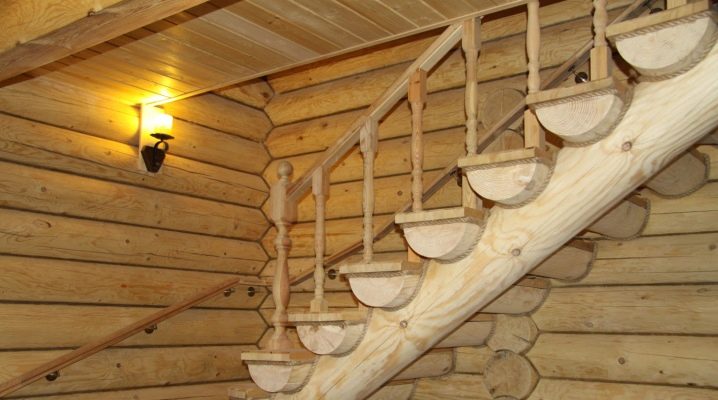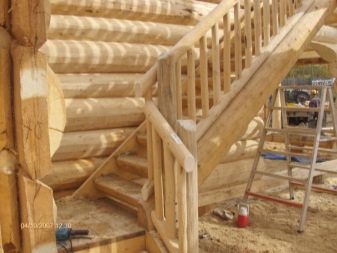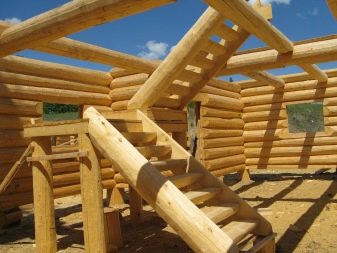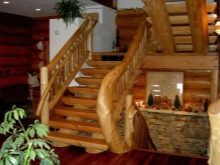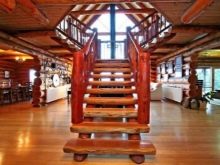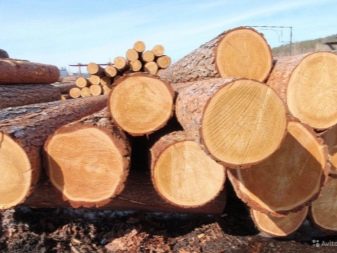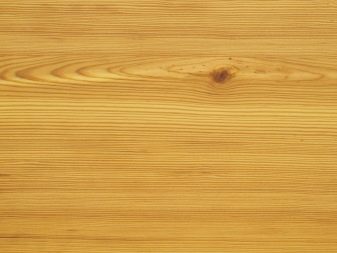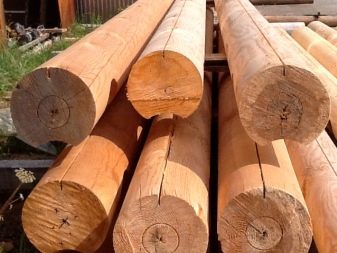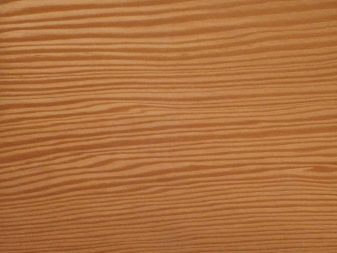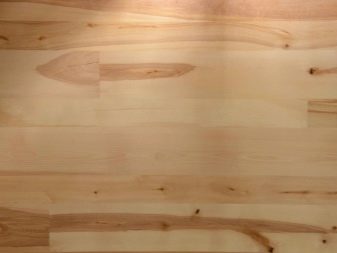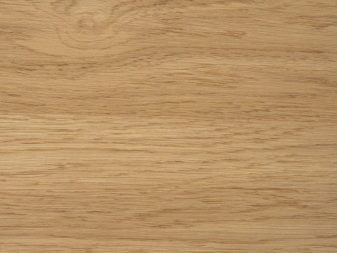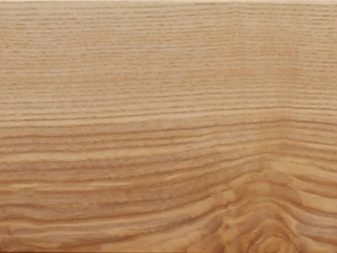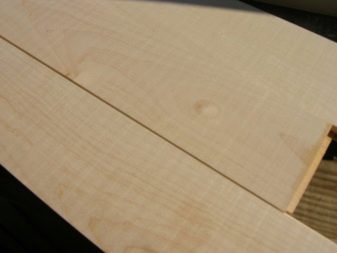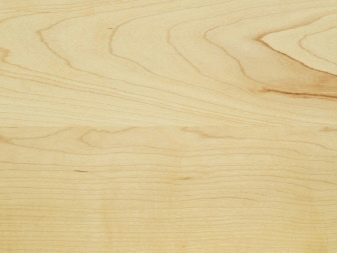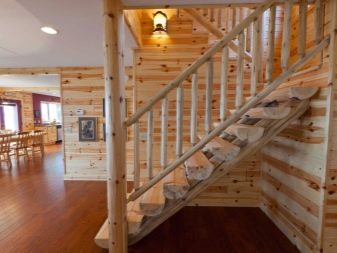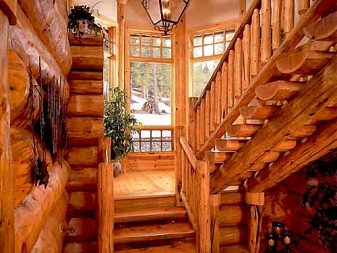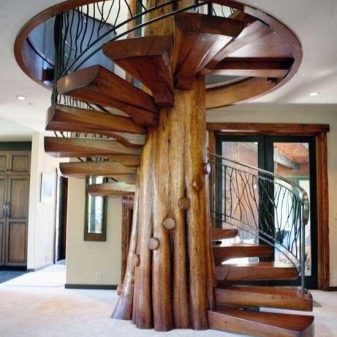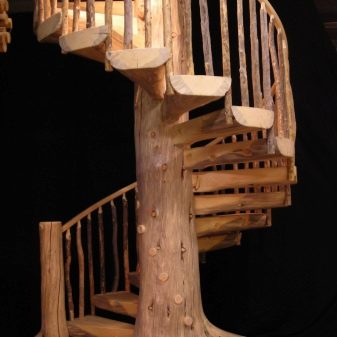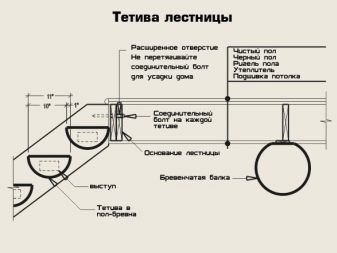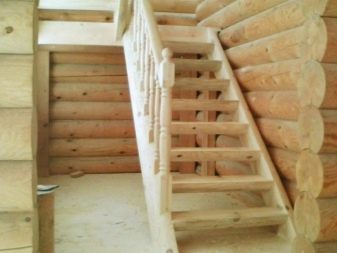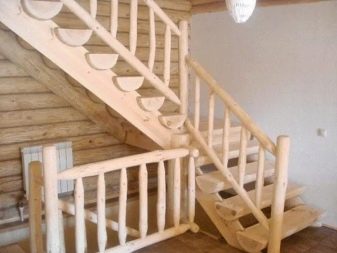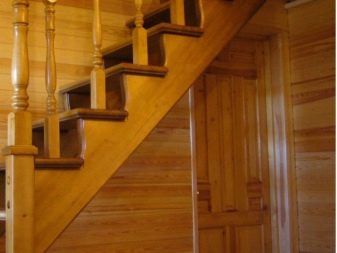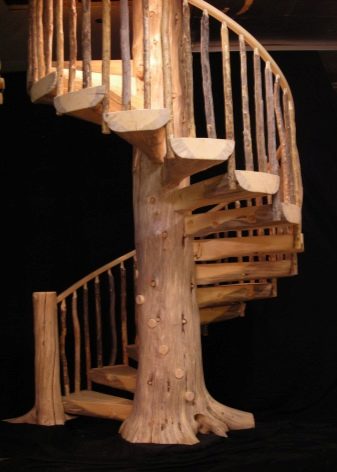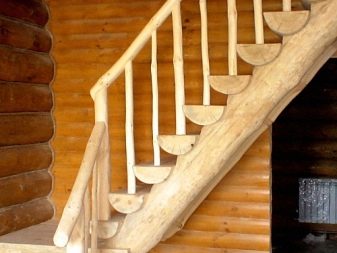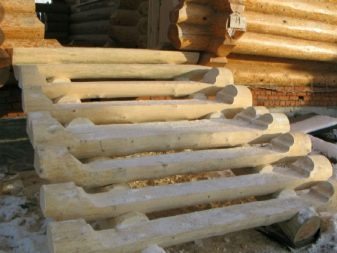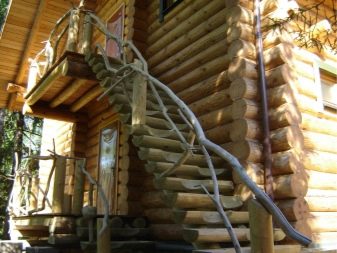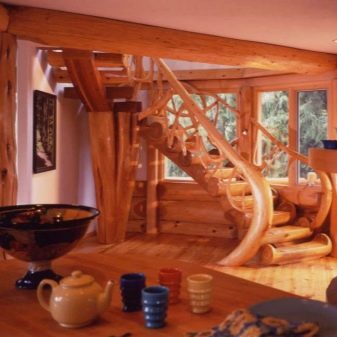Log stairs: a variety of shapes and designs
A staircase made of logs is one of the options for moving between floors in a private house. When creating, various technologies can be used, which determine both the general shape of the structure, for example, the cruise or screw design, and the design of individual elements, for example, steps. Breed of a tree also plays an important role in a question of operational and esthetic features of a ladder.
Features of log constructions
The tree still remains one of the main building materials, especially in the issues of finishing and erecting low-rise structures: houses, villas and cottages. Ladders are no exception, excellent operational features and the beautiful appearance of wood, as well as the atmosphere of coziness and comfort created by it continue to push this material into first place among other options: metal, glass, concrete and others in the matter of their use for interior work.Chopped material also has many advantages.
In addition to those already listed, the staircase structures made of wood have several advantages.
- Absolute naturalness. The material does not emit toxic substances, does not cause allergic reactions, resin, present in the wood and emit a pleasant smell, in addition, have a positive impact on health and mood.
- Ease of processing. The tree perfectly gives in to cutting, felling, planing, wood and other methods of processing. With skillful use, the material is practically not wasted: it does not crumble, does not break, and so on.
- Durability. When using impregnations according to the specifics of the environment in which the structure will be used, for example, humidity, a wooden ladder will last for many decades, the main thing is to timely renew the protective layer of varnish that prevents rotting, eating by bugs and insects and more.
- Strength. Wood, especially hard rocks, is excellent in abrasion resistance, it can withstand any weight loads possible in a residential environment, does not break, does not crumble and does not peel off from impacts, of course, without the use of sharp objects: knives and axes.
- A wide selection of colors and textures.Even in an inexpensive and affordable segment, you can choose from about 10 breeds. Plus, wood is excellent for painting and opening with varnish, which, in addition to its protective function, can improve aesthetics.
Excellent value for money. If you do not take into account the valuable species, for example, red, oak, cedar and the like, then the result is fully consistent with the money spent.
Basic wood species
When constructing a staircase, inexpensive and affordable conifers, as well as more expensive and exotic species can be used. For the stairs in the country or in the house, but not the main one, but leading, for example, to the attic or attic, you can choose a more economical option, for example, pine. While for the central staircase of a cottage or house you can fork out for a more solid option, for example, oak or cedar.
In general, there are several popular varieties of wood.
- Pine, spruce. The budget option, the material requires special treatment to reduce the resin content. Low hardness determines faster abrasion.
- Oak. Premium option, high-strength and durable wood which is great for creating long-term structures with intensive use.The complexity and the main disadvantage is quite difficult processing due to the solid structure, but it provides excellent performance. Price, like quality, is high.
- Larch. Good quality at an average price, practically does not rot, wood is quite flexible, processing is not difficult, the only negative is a large number of small knots. It can be said that larch is the “golden mean” among wood species for construction needs.
- Birch tree. Like pine, is in the economy segment, wood is flexible and viscous, which ensures the absence of chips.
- Beech. It has a solid and durable wood and at the same time is well treatable by cutting and grinding. Excellent uniform structure creates a calm and warm atmosphere. Beech staircase, like beech parquet, has great resistance to abrasion, while its price is more moderate than that of oak.
- Ash. Excellent material with a distinct texture. It is superior in hardness to oak and, in addition, is very elastic, it is used in places associated with high-intensity human activity, for example, when finishing sports facilities.The main disadvantage is complex drying, wood is prone to cracking.
- Maple. The wood has a light shade, slightly yellowing with time, under the varnish such a tree looks like amber. The material is dense and non-porous, as a result - moisture resistant and durable. Maple is very whimsical when drying, which should be considered when processing impregnation.
Constructional types of stairs
There are two main types of stairs, radically different in their structure.
- Marching It can be performed as a solid descent or be divided into several sections with turns by 90 degrees (standard). Between the sections - marches a small platform is performed, although sometimes, when there is a window in such a place, the platform is made large in size, able to accommodate a chair for a seat or a shelf with flowers, or something else. Marching staircase is convenient, but at the same time it takes up much more space. To save them, they are often located in the corner of the room and are in the shape of the letter “G” or “P”. The owners of spacious houses and cottages prefer T and Sh-shaped stairs for their luxury.
- Screw Often used when supporting the appointment of stairs, for example, in the attic or in the country. A less convenient design is also unsafe for children because of the peculiarity of causing dizziness during fast descent. The variability in these structures lies in the height and relative position of the steps, as well as in the construction of a full or incomplete circle (half-spiral). The main advantage of the spiral staircase is much greater compactness.
Types of mounting steps in the flight of stairs
Two classic schemes offer reliable solutions to the constructional question for specific requests. Each type has bright features. For example, a string is distinguished by its beauty and integrity, while the kosour is simpler to create and withstands heavy loads.
Bowstring
One of the main types is distinguished by its simplicity of execution — boards are used as clamps that close the butt end, which ultimately improves the appearance of the structure. To fix the steps in the string, the grooves are cut out. There are many options: this is the angular grooves for the steps with or without risers and overhang, straight grooves for standard steps, stripes and steps from the bars for the steps instead of the grooves and others.Fixing the bowstrings to the floor and ceiling, if the stairs are made in several parts, then to the marches. The structural integrity of the spans is ensured by the compression of all the steps with a string on both sides, therefore, none of the steps can fall out without destroying the string.
The design is practical and unpretentious.
Kosoura
The main bearing element - kosour - is a beam or two beams, which are under the steps, on which they are fixed. Two main types can be distinguished: kashour with gash, it is notched type, and kosour with filly. The first option is simpler and more common. In general, it is easier to make a ladder on kosoura than on bowstrings, and at the same time it can withstand much more serious pressure on the steps. You can make kosour from solid or glued boards. First kosour with teeth or fillies is made, then steps are mounted on top. They can be with or without overhangs. The number of kosour depends on the expected load on the stairs.
Features spiral staircase
It is worth a special mention because of its external dissimilarity with all types of marching stairs. Structurally, there are two main options.In the first stage, the logs of logs are inserted into the grooves cut inside a vertically standing log, which, by principle, resembles kosour. The second variant resembles a hybrid version of a kosour with one string: the steps cut into the log, as in the first variant, and from the second side they are supported by a bent string. This option is costly due to the high cost of a bent element made of flexible and viscous wood. The advantage is a beautiful appearance - the string is often decorated with a carving pattern.
The main advantages of spiral staircases are: space saving, lower material costs and better aesthetic qualities.
Options for the execution of stairs from logs
When using logs, classical schemes: a bowstring and kosour acquire certain specifics. In addition, there are options that apply only to logs. As a result, there are several basic options for the construction of stairs.
These include:
- staircase made of solid log, in which the steps are carved, it can be said, staircase-kosour without steps;
- construction with steps from log halves, fixed in the skidding by the through method;
- ladder-string with steps-blocks of logs;
- staircase at a steep angle, almost hanging, steps made of round timber installed through the method;
- a corkscrew design with turns by a third and a quarter and steps from the halves of a log and so on.
Related design
In addition to the main elements of the logs - support and steps - to give a more aesthetic look, the design can be supplemented with protective equipment and decorated with additional elements.
These products include handrails - a pledge of security, the following options are possible:
- simple regular geometric shape;
- figured;
- carved, decorative;
- combined.
The provided step-by-step instructions for creating a semi-wooden staircase with your own hands will help you complete the work as soon as possible and without any extra effort. Today is quite popular swivel design of half a log with a discreet decor.
To learn how to make your own ladder from logs, see the following video.
